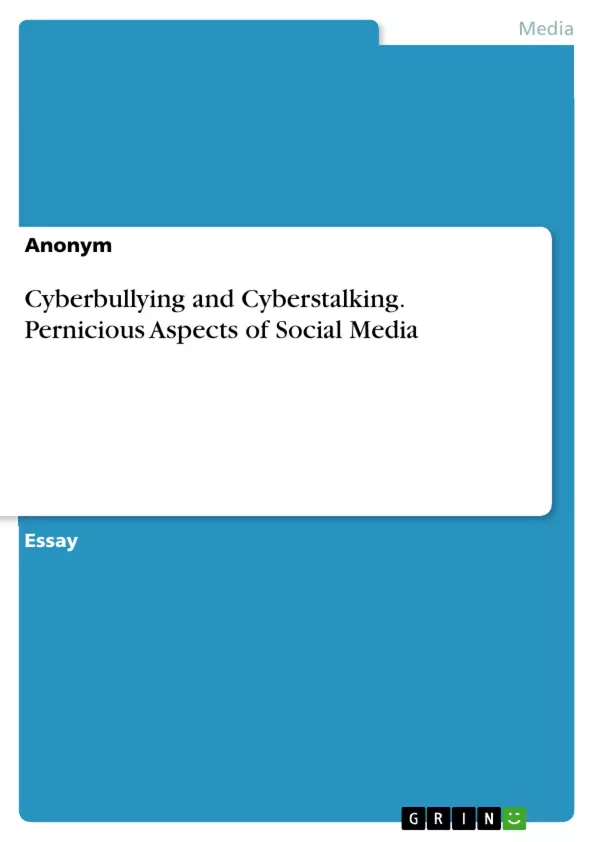This paper discusses some of the most pernicious and dangerous aspects of social media. What can be done to control these? Technology and online communication nowadays play a major role in many aspects of our daily lives. Especially, when it comes to social media companies, including Facebook, Instagram, Twitter, Snapchat, Ask.fm or Kik. Many people, particularly young children, use various social media platforms to communicate with friends or their family, to get inspired, to grow personally, for international business purposes, to develop new relationships or for entertainment purposes.
Along with the growth in usage of social media, however, there are increasing concerns over its benefits as well as safety. One of the pernicious concerns of social media is cyberbullying, as well as cyberstalking. Recent studies indicate that in 2009 and 2011 5 - 40 % of young users are victims of a cyberbullying incidents. The fact that many of these incidents end up with tragic suicide, constitutes cyberbullying as one of the most dangerous aspect of social media.
Table of Contents
- Cyberbullying and Cyberstalking as Pernicious Aspects of Social Media
- Cyberbullying
- Cyberbullying Stereotypes or Tactics
- Causes of Cyberbullying
- Prevention Strategies
- Cyberstalking
- Forms of Cyberstalking
- Motives for Cyberstalking
- How to Respond or Protect Yourself from Cyberstalking
Objectives and Key Themes
This essay examines the negative aspects of social media, specifically cyberbullying and cyberstalking. It explores the prevalence, tactics, and motivations behind these behaviors. Furthermore, the essay discusses preventive measures and strategies for victims to protect themselves.
- The impact of cyberbullying and cyberstalking on individuals and society
- The prevalence and tactics used by cyberbullies and cyberstalkers
- The psychological and social consequences of cyberbullying and cyberstalking
- Prevention strategies for parents, educators, and technology platforms
- The importance of understanding the motivations behind cyberbullying and cyberstalking
Chapter Summaries
- The essay begins by defining cyberbullying and cyberstalking, highlighting their significant impact on individuals, particularly young social media users. It emphasizes the importance of addressing these issues due to their potential for causing emotional distress and even suicide.
- The essay further explores the common forms of cyberbullying, including flaming, harassment, denigration, masquerading, and social exclusion. It provides examples of each form and the harm they inflict on victims.
- The essay then delves into the various motives that drive cyberbullying, including seeking revenge, jealousy, a desire for social power, entertainment, and pressure to fit in. It explores the anonymity provided by the internet as a factor contributing to increased cyberbullying.
- The essay outlines the different forms of cyberstalking, including making threats, spreading false accusations, false victimization, abusing the victim through offensive emails, attacks on data and equipment, gathering information about the victim, involving others in harassment, and physically stalking or attacking the victim.
- The essay explores the motivations behind cyberstalking, suggesting that, while many perpetrators are "normal" individuals, they are driven by various factors, such as a desire for control, power, or revenge.
Keywords
Cyberbullying, cyberstalking, social media, online harassment, digital safety, prevention strategies, psychological impact, social consequences, motivation, tactics, victims, perpetrators.
- Arbeit zitieren
- Anonym (Autor:in), 2018, Cyberbullying and Cyberstalking. Pernicious Aspects of Social Media, München, GRIN Verlag, https://www.grin.com/document/536785



